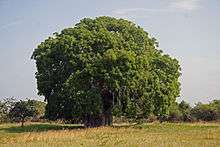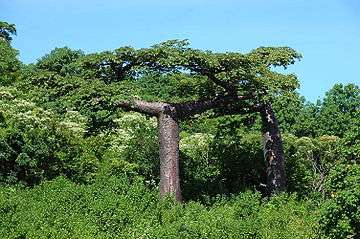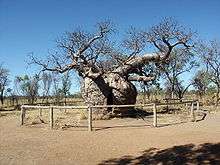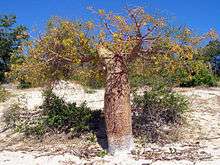Adansonia
| Adansonia | |
|---|---|
 | |
| Adansonia digitata in Tanzania | |
| Scientific classification | |
| Kingdom: | Plantae |
| (unranked): | Angiosperms |
| (unranked): | Eudicots |
| (unranked): | Rosids |
| Order: | Malvales |
| Family: | Malvaceae |
| Subfamily: | Bombacoideae |
| Genus: | Adansonia L.[1] |
| Species | |
|
See Species section | |
Baobab is the common name for each of the nine species of tree in the genus Adansonia. The generic name honours Michel Adanson, the French naturalist and explorer who described Adansonia digitata.
Of the nine species, six are native to Madagascar, two are native to mainland Africa and the Arabian Peninsula, and one is native to Australia. One of the mainland African species also occurs on Madagascar, but it is not a native of that island. It was introduced in ancient times to south Asia and during the colonial era to the Caribbean. It is also present in the island nation of Cape Verde.[2] The ninth species was described in 2012, and is found in upland populations of southern and eastern Africa.[3] The African and Australian baobabs are almost identical, having separated less than 100,000 years ago.[4]
Baobabs reach heights of 5 to 30 m (16 to 98 ft) and have trunk diameters of 7 to 11 m (23 to 36 ft). The Glencoe baobab, a specimen of A. digitata in Limpopo Province, South Africa, was considered to be the largest living individual, with a maximum circumference of 47 m (154 ft)[5] and a diameter of about 15.9 m (52 ft). The tree has since split into two parts, so the widest individual trunk may now be that of the Sunland baobab, or Platland tree, also in South Africa. The diameter of this tree at ground level is 9.3 m (31 ft) and its circumference at breast height is 34 m (112 ft).[6]
Adansonia trees produce faint growth rings, probably annually, but they are not reliable for aging specimens, because they are difficult to count and may fade away as the wood ages. Radiocarbon dating has provided data on a few individuals. A specimen of A. digitata known as Grootboom was dated and found to be at least 1275 years old, making it one of the oldest known angiosperm trees.[6][7]
Habitat
The Malagasy species are important components of the Madagascar dry deciduous forests. Within that biome, Adansonia madagascariensis and A. rubrostipa occur specifically in the Anjajavy Forest, sometimes growing out of the tsingy limestone itself. A. digitata has been called "a defining icon of African bushland".[7]

Species
Species include:[8]
- Adansonia digitata L. – African baobab, dead-rat-tree, monkey-bread-tree (western, northeastern, central & southern Africa, in Oman and Yemen in the Arabian Peninsula, Asia and in Penang, Malaysia[9])
- Adansonia grandidieri Baill. – Grandidier's baobab, giant baobab (Madagascar)
- Adansonia gregorii F.Muell. (syn. A. gibbosa) – boab, Australian baobab, bottletree, cream-of-tartar-tree, gouty-stem (northwestern Australia)
- Adansonia kilima Pettigrew, et al. – montane African baobab (eastern & southern Africa)[3]
- Adansonia madagascariensis Baill. – Madagascar baobab (Madagascar)
- Adansonia perrieri Capuron – Perrier's baobab (northern Madagascar)
- Adansonia rubrostipa Jum. & H.Perrier (syn. A. fony) – fony baobab (Madagascar)
- Adansonia suarezensis H.Perrier – Suarez baobab (Madagascar)
- Adansonia za Baill. – za baobab (Madagascar)
Water storage
Baobabs store water in the trunk (up to 100,000 litres or 26,000 US gallons) to endure harsh drought conditions.[10] All occur in seasonally arid areas, and are deciduous, shedding their leaves during the dry season.
Uses
Some baobab species are sources of fiber, dye, and fuel. Indigenous Australians used the native species A. gregorii for several products, making string from the root fibers and decorative crafts from the fruits.
A large, hollow baobab south of Derby, Western Australia, is said to have been used in the 1890s as a prison for convicts on their way to Derby for sentencing. The Boab Prison Tree, Derby still stands and is now a tourist attraction.[11] Although the baobab tree near Derby might not have been used as a prison, a similar hollow baobab tree near Wyndham Australia actually was.[12]
Food uses
Since 2008, interest has been increasing for developing baobab seeds or dried fruit powder for consumer products.[13][14] In the European Union (EU) prior to commercial approval, baobab fruit powder was not available for ingredient uses, as legislation from 1997 dictated that foods not commonly consumed in the EU would have to be formally approved first. In 2008, baobab dried fruit pulp was authorized in the EU as a safe food ingredient,[15] and it was later granted GRAS status in the United States.[16]
The fruit has a velvety shell and is about the size of a coconut, weighing about 1.5 kilograms (3.3 lb). It has an acidic, tart flavor, described as "somewhere between grapefruit, pear, and vanilla".[17] The fresh fruit is said to taste like sherbet.[18]
The dried fruit powder of A. digitata contains about 12% water and modest levels of various nutrients, including carbohydrates, pectin, riboflavin, calcium, magnesium, potassium, iron, and phytosterols, with low levels of protein and fats.[17][19][20][21] Vitamin C content, described as variable in different samples, was in a range of 74–163 mg per 100 g of dried powder.[17]
The powdery white interior may be used as a "thickener in jams and gravies, a sweetener for fruit drinks, or a tangy flavor addition to hot sauces".[20] The fruit pulp and seeds of A. grandidieri[22] and A. za are eaten fresh.[23] In Tanzania, the dry pulp of A. digitata is added to sugar cane to aid fermentation in beermaking.[24] The seeds of some species are a source of vegetable oil[22][23] and leaves may be eaten as a leaf vegetable.[7]
In Angola, the dry fruit is usually boiled and the broth is used for juices or as the base for a type of ice cream known as gelado de múcua. In Zimbabwe, the fruit is used in traditional food preparations which include "eating the fruit fresh or crushed crumbly pulp to stir into porridge and drinks". Malawi women have set up commercial ventures harvesting the baobab to earn their children's school fees.
Ecology
Baobabs are important as nest sites for birds, in particular the mottled spinetail[25] and four species of weaver.[26]
Gallery
| Wikimedia Commons has media related to Adansonia. |
| Wikispecies has information related to: Adansonia |
-

Adansonia digitata at Thalassery, Kannur, Kerala, India
References
- ↑ "Genus: Adansonia L.". Germplasm Resources Information Network. United State Department of Agriculture. 2008-11-12. Retrieved 2011-01-14.
- ↑ Wickens, G. E.; Lowe, P. (2008). The Baobabs: Pachycauls of Africa, Madagascar and Australia. Berlin, Germany; New York, NY: Springer Verlag. ISBN 978-1-4020-6430-2. OCLC 166358049.
- 1 2 Pettigrew, J. D.; et al. (2012). "Morphology, ploidy and molecular phylogenetics reveal a new diploid species from Africa in the baobab genus Adansonia (Malvaceae: Bombacoideae)" (PDF). Taxon. 61: 1240–1250.
- ↑ Baum D. A., Small R. L., Wendel J. F. Biogeography and floral evolution of baobabs (Adansonia, Bombacaceae) as inferred from multiple data sets. Syst Biol 1998; 47:181–207.
- ↑ "Big Baobab Facts". Archived from the original on 2008-01-06. Retrieved 2008-01-08.
- 1 2 Patrut, A., et al. (2010). Fire history of a giant African baobab evinced by radiocarbon dating. Radiocarbon 52(2), 717-26.
- 1 2 3 "Adansonia digitata (baobab)". Royal Botanic Gardens, Kew. Retrieved 2014-06-08.
- ↑ "GRIN Species Records of Adansonia". Germplasm Resources Information Network. United State Department of Agriculture. Retrieved 2011-01-14.
- ↑ Gardner, Simon; Sidisunthorn, Pindar; Lai, Ee May (2011). Heritage Trees of Penang. Penang: Areca Books. ISBN 978-9-675-71906-6.
- ↑ "The Baobab tree in Senegal". Archived from the original on 2008-10-04. Retrieved 2008-10-01.
- ↑ "Tourist Information: Derby". Shire of Derby, West Kimberley. Retrieved 2014-06-08.
- ↑ "Dance of the baob". The Australian Women's Weekly. National Library of Australia. 2 February 1966. p. 26. Retrieved 11 January 2012.
- ↑ "Scientists predict African fruit trees could help solve major public health problem". Bioversity International. Retrieved 2008-10-01.
- ↑ Hills, Sarah (2008-09-30). "Baobab goes for GRAS ahead of 2010 World Cup". FoodNavigator-USA.com. William Reed Business Media. Retrieved 2014-06-08.
- ↑ "Baobab dried fruit pulp". UK Food Standards Agency. 2008. Retrieved 2012-06-03.
- ↑ "Agency Response Letter GRAS Notice No. GRN 000273". Fda.gov.
- 1 2 3 UK Advisory Committee on Novel Foods and Processes (July 2008). "Baobab dried fruit pulp. EC No. 72; August 2006: Application from PhytoTrade Africa to approve baobab dried fruit pulp as a novel food ingredient. Authorised July 2008". UK Food Standards Agency. Retrieved 2012-06-03.
- ↑ "Adansonia gregorii". Australian Tropical Rainforest Plants. Retrieved 2014-06-08.
- ↑ Osman, M. A. (2004). "Chemical and nutrient analysis of baobab (Adansonia digitata) fruit and seed protein solubility". Plant Foods Hum Nutr. 59 (1): 29–33. doi:10.1007/s11130-004-0034-1. PMID 15675149.
- 1 2 "New exotic fruit to hit UK shops". BBC. 2008-07-15. Archived from the original on March 7, 2009. Retrieved 2008-07-15.
- ↑ Chadare, F. J.; et al. (2009). "Baobab food products: a review on their composition and nutritional value". Crit Rev Food Sci Nutr. 49 (3): 254–74. doi:10.1080/10408390701856330. PMID 19093269.
- 1 2 Ambrose-Oji, B. and N. Mughogho. 2007. Adansonia grandidieri Baill. In: van der Vossen, H. A. M. and G. S. Mkamilo (Eds). PROTA 14: Vegetable oils/Oléagineux. PROTA, Wageningen, Netherlands.
- 1 2 Ambrose-Oji, B. and N. Mughogho. 2007. Adansonia za Baill. In: van der Vossen, H. A. M. and G. S. (Eds). PROTA 14: Vegetable oils/Oléagineux. PROTA, Wageningen, Netherlands.
- ↑ Sidibe, M., et al. Baobab, Adansonia digitata L. Volume 4 of Fruits for the Future. International Centre for Underutilised Crops, 2002.
- ↑ "Species text in The Atlas of Southern African Birds" (PDF). Retrieved 2014-10-30.
- ↑ "Weavers breeding in baobabs". Animal Demography Unit, Department of Biological Sciences, University of Cape Town, South Africa. Retrieved 2014-10-30.
Further reading
| Wikisource has the text of the 1911 Encyclopædia Britannica article Baobab. |
- Baum, D. A., et al. (1998). Biogeography and floral evolution of baobabs (Adansonia, Bombacaceae) as inferred from multiple data sets. Systematic Biology 47(2), 181–207.
- Braun, K. (1900) Beiträge zur Anatomie der Adansonia digitata L. F. Reinhardt, Universitäts-Buchdruckerei, Basel, OCLC 15926986
- Lowe, P. The Boab Tree. Port Melbourne, Australia: Lothian. ISBN 0-85091-912-6
- Pakenham, T. The Remarkable Baobab. New York: Norton. 2004. ISBN 0-393-05989-8
- Watson, R. The African Baobab. Cape Town, London: Struik. 2007. ISBN 978-1-77007-430-9


